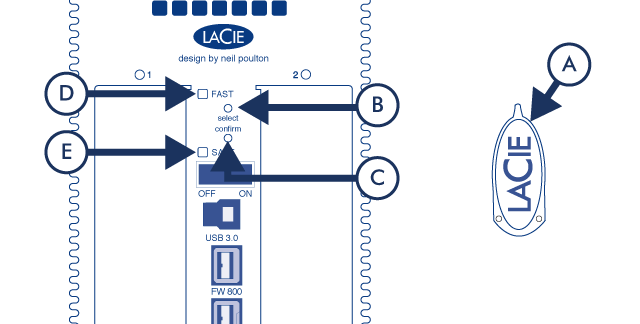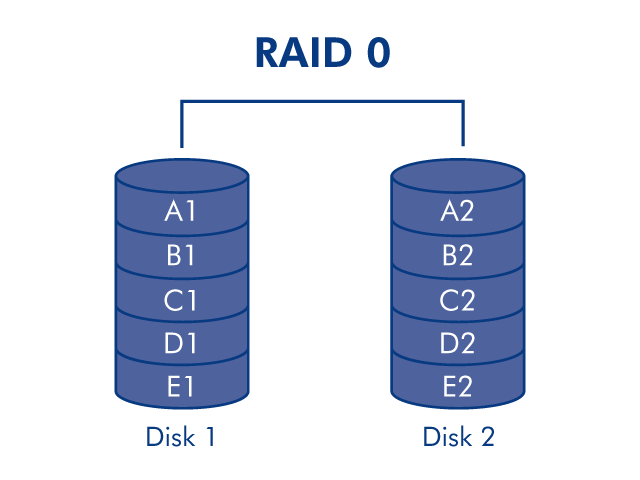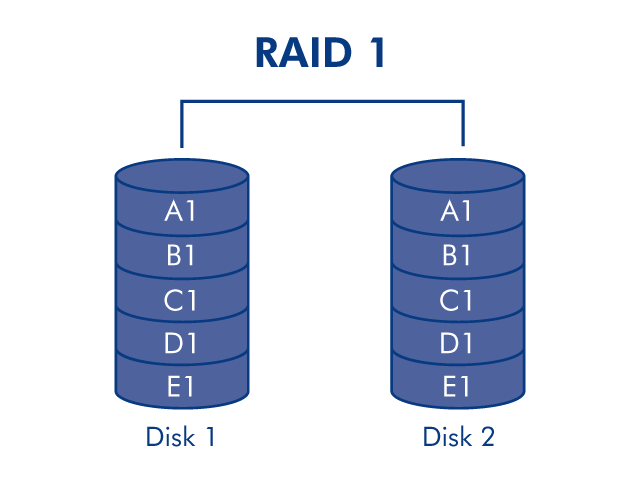User Tools
Site Tools
Table of Contents
Table of Contents
Manage RAID
Modify RAID Mode
- Make sure that the 2big is turned off but that its power supply is connected and that it's connected to a computer via an interface cable.
- Use the sharp end of the RAID selection tool (A) to press and hold down the select button (B).
- Without releasing the select button, turn on the product.
- Once the RAID mode LEDs (D and E) start blinking (takes five seconds), release the select button.
- The LED for the current RAID mode (D or E) will blink. Using the RAID selection tool, press the select button (B) to toggle between the two different modes.
- Once the LED for the RAID mode you want is blinking, press the confirm button (C). RAID initialization will begin and will take less than one minute.
- Next you must format the volume before it will mount on your computer. For instructions, refer to Formatting Instructions.
About RAID Modes
Refer to the table below for an overview of the different RAID modes, and see the descriptions for details.
| RAID Mode | Capacity | Protection | Speed | Factory Default |
|---|---|---|---|---|
| RAID 0 (FAST) | 100% | None | Excellent | Yes |
| RAID 1 (SAFE) | 50% | Excellent | OK | No |
RAID 0 (FAST): RAID 0, is the fastest RAID mode. In a RAID 0 array, the available capacities of each drive are added together so that one logical volume mounts on the computer. It offers the best performance but no protection in the case that a drive fails.
RAID 1 (SAFE): RAID 1 provides data safety since all data is written to each drive at the same time. In the event of a single drive failure, data remains available on the other drive. Due to the time it takes to write the data twice, performance is slightly reduced. RAID 1 is a good choice when safety is more important than speed. However RAID 1 also reduces the available drive space by 50% due to the need to write each bit of data on each hard drive.
Replace Drive
Remove Drive
If your array is protected, ie in a RAID 1/SAFE mode, you can remove a drive without damaging the array and losing data, a process also referred to as “hot-swapping”. However, if you remove a drive from an unprotected (ie RAID 0/FAST) array, you may lose data.
- The drive tray may be locked. To unlock it, use the included RAID selection tool to turn the lock until the slot is vertical.
- Draw out the drive tray by inserting your finger into the space behind the drive tray handle and pulling to disengage the drive.
- Grasp the drive tray handle and carefully extract the drive.
Replace Drive
Note that for optimum storage use, the new drive should have equal or greater capacity than the drive it is replacing.
- Carefully insert the drive tray into an empty drive bay. When the drive tray is most of the way in and you feel resistance, press the drive tray handle firmly until you feel the drive snap into place and the drive tray handle is flush with the back of the product.
- Use the RAID selection/drive removal tool to lock the drive.
- The next steps depend on which RAID mode was in place when the old disk was removed:
- If the RAID mode was 0 (FAST): all data stored on the device has been deleted, and you need to follow the steps below in order to reinitialize the RAID 0.
- Change the RAID mode to RAID 1 (SAFE) by following the instructions in Modify RAID Mode.
- Make sure that the RAID 1 mode (SAFE) is ready. This will be indicated by a steady blue LED on the front of the product, and the SAFE mode LED illuminated on the rear of the product.
- Turn off your product again and change the RAID mode back to RAID 0 (FAST), by following the same procedure as above.
- After a brief initialization, the LED indicating a clean RAID 0 (FAST) will be illuminated, and the front LED will become steady blue.
- Reformat the volume (refer to Formatting Instructions for details). Once this is complete, the volume for the clean RAID 0 arrray will mount on your computer.
- If the RAID mode was 1 (SAFE):
- Connect the power supply and turn on the product.
- Drive synchronization will begin automatically. The front LED and two drive LEDs will blink blue until synchronization has completed.

 Print page
Print page Save page as PDF
Save page as PDF




